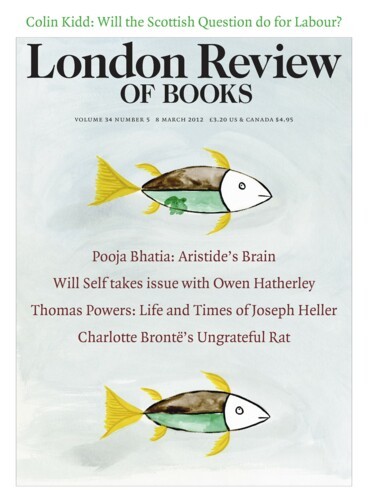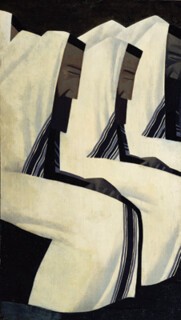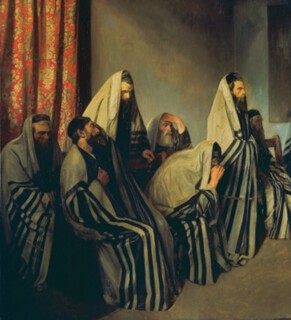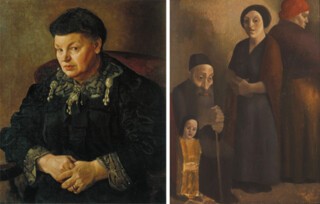‘Troubling’: that’s the word chosen by Penelope Curtis, the new director of Tate Britain, in her preface to the catalogue for Migrations, the gallery’s recently opened exhibition (it closes on 12 August). She’s referring to the name of the institution she heads. The launch of Tate Modern in 2000 gave Tate curators the thankless and well nigh incoherent task of demarcating which of their holdings belonged to a story about a specific nation and which to a story about value systems in general. Equally awkward has been the relation between the nation in question, ruled from London, and the more symbolically potent local allegiances that divide the island geographically. Now, however, Curtis sees a need to multiply the conundrums of Tate Britishness.
She is looking at the same tangle of questions explored by Jeremy Harding in his essay ‘Europe at Bay’ in the LRB of 9 February. Coming at the politics of migration via the experience of an Afghan refugee waiting to enter Britain, Harding also took us through its philosophical dimensions. Two contrasting approaches, ‘communitarian’ and ‘cosmopolitan’, fight it out. The former ‘proposes a bounded, particular set of priorities and interests’, typically national or ethnic; the latter, ‘a kind of global ethics, ambitious and unwieldy’. Cosmopolitanism ‘might be dismissed as utopian, were it not for the fact that human movement across borders is set to continue, with or without an international consensus about how it’s regulated’. Curtis suggests that Tate Britain, an inherently communitarian enterprise, ought to address that fact of contemporary history. Art could confront politics with lived experience – with the stories of migrants, memorably symbolised. Art could take on political dimensions as it reaffirms the necessity of the utopian.
In this light the hefty centrepiece of Migrations – a selection of Tate holdings organised, at Curtis’s behest, by Lizzie Carey-Thomas – is the 59-minute film Handsworth Songs. In the wake of the 1985 Handsworth riots, the Black Audio Film Collective cross-cut reportage of police lines and burning cars and reactions from black and Asian eyewitnesses with postwar newsreels of freshly arrived, earnestly genteel Caribbean immigrants and still older footage of the Black Country in its heavy-industrial heyday. These materials come together as a tale of a temporarily useful workforce led on by an ‘unrequited love for Englishness’ (the words of Kodwo Eshun in a catalogue text) who then raged as that love was spurned. Offbeat edits, cameras swinging up to the louring skies over the redbrick terraces and the haunting metallic echoes of Mark Stewart’s dub ‘Jerusalem’ render the tale mythically large and affecting. ‘Let those to whom history has not been friendly,’ the voiceover grandly concludes, ‘bear witness to the process by which the living transform the dead into partners in struggle.’
This monumental work rubs shoulders with slighter products of the 1980s black art movement: only Lubaina Himid’s mythopoeic canvas of her female ancestors making the sea-crossing stands up among much scratchy facetiousness. The turn from compliance to rage that the film charts is echoed in the career of Rasheed Araeen, who, coming to London from Karachi, gave 1960s minimalist sculpture an exuberant South Asian twist. Feeling that the results were categorised as mere exotica, he re-emerged as a dirty protester, in photomontages defacing his own Islamic heritage. But how remote such 1980s art warring has come to seem, how uncouth in its communitarian accents. Nomadism, as T.J. Demos points out in an essay in the catalogue, has taken over as a prevalent art-world mode, exemplified by city-hoppers such as the Belgian Francis Alÿs. A video follows Alÿs insouciantly striding along, running a stick against lines of London railings. No ‘bearing witness’ there: merely the buoyancy of a gratuitous passing intervention. The ethos might be traced back to the Filipino-born David Medalla, who contributes to the display a sweetly daft 1963 bubble machine and to the catalogue an equally absurd extravaganza of name-dropping. (He meets everyone from James Dean, ‘one of the first people to encourage my art’, to Elias Canetti, ‘the writer of Auto da Fé, with whom I drank cups of coffee in the cafés of Hampstead, while discussing the merits of Chinese civilisation’.) Demos finds something facile in nomadic cosmopolitanism, relating it to the ‘triumphalist neoliberal globalisation’ of the 1990s, and suggests that it ill befits a present in which the nation-state has become resurgent. But then, contemporary art has acquired a knack for keeping out of step with politics.
Eshun tries out the thought that earlier migrations to Britain – specifically those of Jews fleeing early 20th-century Europe – might shed light on the fortunes of the African diaspora. You might indeed find a fore-echo of more recent tensions in the gap between an assimilationist William Rothenstein, depicting East End Jews in mourning robes in the handsomest Slade manner of 1906, and Jacob Kramer imbuing the same imagery with primitivist ferocity 13 years later. Their works are joined in the exhibition by those of Epstein and Bomberg, Jankel Adler, Mark Gertler and Hans Feibusch – all artists of formidable moral gravity, tellingly brought together.
This Jewish section is the show’s fourth: it’s preceded by three other groupings, covering first the 16th and 17th centuries, then the neoclassical era, before hopping between Paris and London in the late 19th century. Curtis and Carey-Thomas have enlarged on Eshun’s thought: surely – can it politely be disputed? – a historical long view of migration’s effect on the visual arts ought to illuminate our current situation. But it turns out it doesn’t. For these purposes, so their experiment discloses, art history is bunk. All they manage to trace with captions that tie Van Dyck, Roubiliac, Zoffany, Whistler and Kokoschka to their overseas origins (though not – and why not? – other visitors or settlers: Rubens, Pissarro, Freud) is the trite proposition that ‘the national collection of British art is frequently not actually British,’ as Curtis problematically phrases it. I’d have thought that the ‘actually’ in that sentence is exactly the qualifier this venture ought to be refusing to buy.
One borrowed exhibit, a Canaletto of 1740s Westminster, renders a particular local streetscape with poignant acuity. Like John Akomfrah, the Ghanaian-born director of Handsworth Songs, the Venetian is reminding me what I take Britishness to look like. But their works come as oases in a fuzzy and overstretched survey, only flickeringly illumined by any emotional or formal logic. There ought to be an invigorating tension here. Cosmopolitan utopianism – no-place-ness – is alluring but vaporous, while communities are the seedbeds of both strong symbolism and gate-slamming politics. But such an argument has hardly been translated to the gallery.
Send Letters To:
The Editor
London Review of Books,
28 Little Russell Street
London, WC1A 2HN
letters@lrb.co.uk
Please include name, address, and a telephone number.




